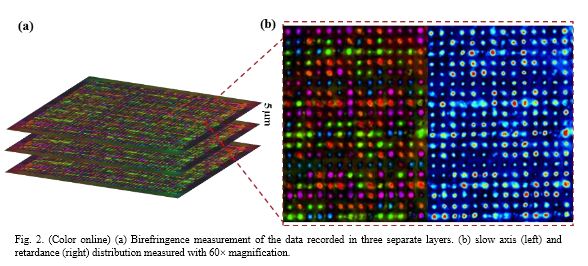
A New Dimension (or Two?) for Long-Term Data Storage
A group of scientists at the University of Southampton is pushing the frontier of long-term data storage technology to a new level. At a recent Conference on Lasers and Electro-Optics in San José, the researchers announced their success at recording data in quartz glass by using a femtosecond laser.
A femtosecond, or ultrafast, laser sends out a quadrillion (that’s a 1 with 15 zeros) pulses per second. When focused on a piece of quartz glass, these photon bullets shift the structuring of atoms in the silica, creating what are called nanostructures. The presence of nanostructures changes the way light travels through the quartz, which means they can be ‘read’ by an optical microscope.
Taking advantage of this fact, these Southampton researchers figured out how to use an ultrafast laser to deliberately place nanostructured dots within the quartz glass. A configuration of dots can thereby become five-dimensional code, conveying meaning through its spatial position within the quartz (dimensions one, two, and three), as well as the size and directional orientation of the dot (dimensions four and five). Using this ‘code’, the research team successfully recorded a 300 kb digital text file into a piece of quartz glass, in the form of a holographic ‘image’ of dots that can be read with an optical microscope fitted with a polarizing filter.
Silica quartz is attractive as a base for very long-term storage because, like sapphire or nickel, it is strong and resistant to high temperatures up to 1000° Celsius. The Southampton research team claims that quartz glass could last for a million years:
“It is thrilling to think that we have created the first document which will likely survive the human race, said Peter Kazansky, professor of physical optoelectronics at the Univ. of Southampton’s Optical Research Centre. “This technology can secure the last evidence of civilization: all we’ve learnt will not be forgotten.”
Beyond the strength of its material, the potential of this new technology lies in the nano-scale of its encoding: at that order of magnitude (or microtude, if you will), the researchers suggest, a single piece of quartz could hold more than 350 terabytes of data. If this technology can be translated into a real-world utility, the researchers claim this new form of data storage
“… could be highly useful for organizations with big archives. At the moment companies have to back up their archives every five to ten years because hard-drive memory has a relatively short lifespan,” says [principal investigator Jingyu Zhang]. “Museums who want to preserve information or places like the national archives where they have huge numbers of documents, would really benefit.”
Join our newsletter for the latest in long-term thinking
Subscribe